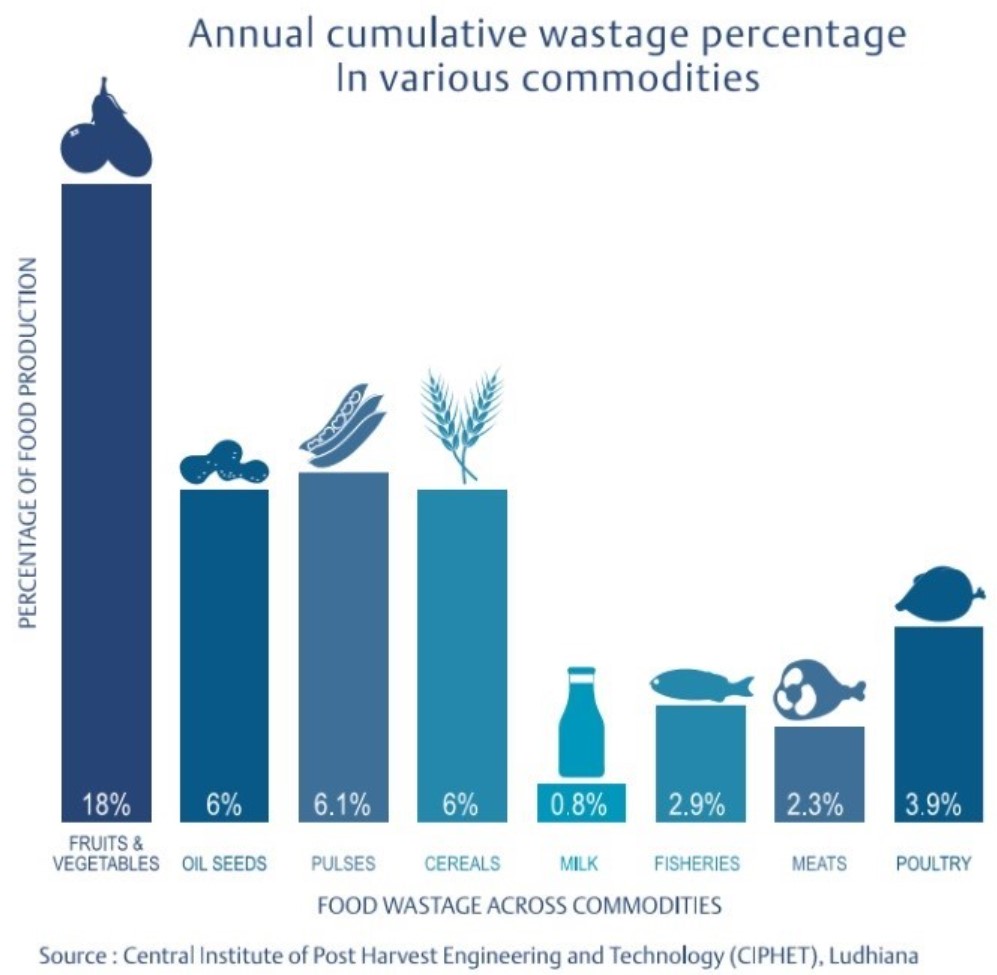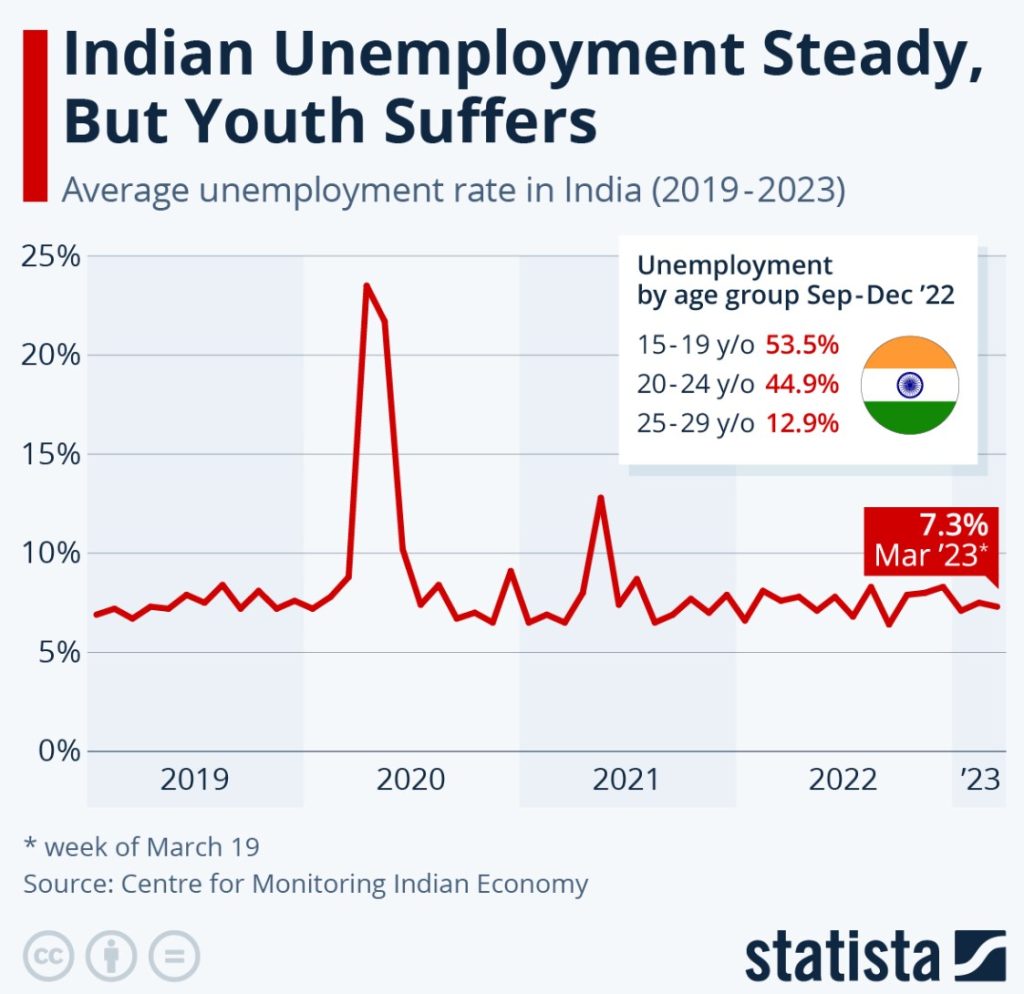CONTENTS
- Choosing the Right Track to Cut Post-Harvest Losses
- Using Technology in Search of Jobs
Choosing the Right Track to Cut Post-Harvest Losses
Context:
India is the world’s second-largest agricultural producer, but it ranks eighth in global agricultural exports, with only a 2.4% share. This disparity is due to factors like low productivity, failure to meet quality standards, and supply chain inefficiencies, including inadequate transportation and infrastructure, leading to significant post-harvest losses.
Relevance:
GS3-
- Storage, Transport and Marketing of Agricultural Produce and Issues and Related Constraints
- E-technology in the aid of farmers
- Issues of Buffer Stocks and Food Security
Mains Question:
While increasing food production to meet the needs of India’s rising population is essential, preventing post-harvest losses is crucial. Discuss. (10 Marks, 150 Words).
Post- Harvest losses- Statistics:

- According to a 2022 study by the Ministry of Food Processing Industries, India’s post-harvest losses amount to approximately ₹1,52,790 crore annually.
- As the population grows, meeting the food and nutrition demands becomes increasingly challenging.
- While increasing food production is essential, preventing post-harvest losses is crucial.
- A closer examination reveals that perishable commodities experience the most significant losses: livestock produce such as eggs, fish, and meat (22%), fruits (19%), and vegetables (18%).
- During export, around 19% of perishable food is lost, especially at the import-country stage. Efficient storage, transportation, and marketing are critical for timely delivery to consumers.
- Strengthening agri-logistics is a priority identified by the Committee on Doubling Farmer’s Income (DFI).
Factors Causing Post- Harvest Losses:
Stages in the Supply-Chain:
- The supply chain involves multiple logistical stages, from initial transport from the farm to wholesale markets, long-haul transportation by rail, road, water, or air, to last-mile delivery to consumers. Perishable goods face time constraints post-harvest.
- The latest agriculture census shows that 86% of Indian farmers are small and marginal, struggling to achieve economies of scale due to small production volumes.
- The lack of assured market connectivity leads to post-harvest and income losses for farmers.
Supply Constraints:
- Food price volatility in India is partly due to supply constraints affecting perishable produce. A NITI Aayog report notes that freight transport, including agricultural produce, drives 75% of the Indian Railways’ revenue.
- The Indian Railways connects urban centers and rural areas efficiently and is crucial for moving 90% of the Food Corporation of India’s food grains.
- However, about 97% of fruits and vegetables are transported by road.
Initiatives by Indian Railways:
- Indian Railways has introduced several initiatives to enhance its freight operations for perishables.
- The truck-on-train service, which transports loaded trucks on railway wagons, is being expanded after successful trials with commodities like milk and cattle feed.
- During the COVID-19 pandemic, parcel special trains were introduced to transport perishables and seeds between markets and producers.
- To support small and marginal farmers (SMFs), the Kisan Rail was launched, connecting regions with surplus perishable production (including milk, meat, and fish) to consumption regions more efficiently.
- A study showed that the Kisan Rail scheme helped reduce post-harvest losses and increased farmer incomes.
- For instance, grape growers in Nashik, Maharashtra, earned a net profit of ₹5,000 per quintal by transporting around 22,000 quintals via Kisan Rail, demonstrating the benefits of rail-based long-haul transport for fruits and vegetables.
Way Forward:
- Recent efforts by the Railways in the agricultural sector have shown promising results. However, there is a need to increase farmer awareness and accessibility to Railway schemes.
- Friends of Champions 12.3 India, a coalition of food supply chain actors powered by WRI India, identified challenges such as multiple touch points during the transport of perishables by Railways.
- Therefore, investing in specialized wagons for temperature-controlled transport and establishing rail-side facilities for safe cargo handling is crucial.
- This would enhance food safety by minimizing spoilage and contamination risks, supporting both domestic and export markets.
- The Doubling Farmer’s Income (DFI) committee recommends streamlining loading and unloading processes to reduce transit times and addressing staffing shortages through recruitment and training.
- Prioritizing railways over roadways, particularly for transporting fruits and vegetables, promises more efficient transportation.
- The Railways present a significant opportunity to reduce post-harvest losses, benefiting both livelihoods and the environment.
- According to the Logistics Division of the Ministry of Commerce, Indian Railways emits up to 80% less carbon dioxide for freight traffic compared to road transport.
Conclusion:
A systems-based approach is necessary, integrating various modes of transport and regions. The private sector can significantly enhance operational efficiency and strengthen rail infrastructure through public-private partnerships. The agriculture budget for 2024 aims to bridge the farm-to-market gap with modern infrastructure and value-addition support. These Railway initiatives complement such efforts by facilitating efficient transportation of perishable goods and minimizing post-harvest losses.
Using Technology in Search of Jobs
Context:
Employment generation will remain a significant challenge for the current government in its third term, and the upcoming Union Budget is expected to address this issue. The growing number of young job seekers and the evolving economy, which requires fewer workers due to rapid technological advancements, complicate the situation.
Relevance:
GS3-
- Mobilization of Resources
- Growth, Development and Employment
- Inclusive Growth and issues arising from it
Mains Question:
The growing number of young job seekers and the evolving economy, which requires fewer workers due to rapid technological advancements, complicate the situation of unemployment in the country. Discuss. (10 Marks, 150 Words).
India’s Unemployment Rate:
- In 2023, India’s unemployment rate for individuals aged 15 and above dropped to 3.1%, the lowest in the past three years.
- This rate was 3.6% in 2022 and 4.2% in 2021. Female unemployment decreased to 3% in 2023 from 3.3% in 2022 and 3.4% in 2021. For males, it fell to 3.2% in 2023 from 3.7% in 2022 and 4.5% in 2021.
Urban and Rural Unemployment:
- Urban unemployment reduced to 5.2% in 2023 from 5.9% in 2022 and 6.5% in 2021.
- Rural unemployment decreased to 2.4% in 2023 from 2.8% in 2022 and 3.3% in 2021.

- The Labour Force Participation Rate (LFPR) in Current Weekly Status (CWS) for individuals aged 15 and above in urban areas rose to 56.2% in 2023, up from 52.8% in 2022 and 51.8% in 2021.
Relevant Studies:
- Recent studies have highlighted the severity of this challenge. The Annual Survey of Unincorporated Sector Enterprises (ASUSE) indicates that only 21% of total establishments used the internet for entrepreneurial activities.
- The survey, echoing a previous International Labour Organisation (ILO) report, notes that the unincorporated non-agricultural economy employed about 11 crore workers from October 2022 to September 2023, up from 9.8 crore workers during 2021-22.
- The ILO’s India Employment Report also warned that manufacturing employment remained stagnant at around 12%-14%, and the slow transition of jobs from agriculture to non-agriculture sectors reversed due to the COVID-19 pandemic.
- A Citigroup report similarly stated that the current rate of job creation is insufficient to meet future demand.
- The ASUSE also found that ‘Other Services’ contributed the most to total employment (36.45%), followed by ‘trading’ (35.61%) and ‘manufacturing’ (27.94%).
- Various Periodic Labour Force Surveys noted that 45.76% of the total workforce was engaged in agriculture and allied sectors during 2022-23.
Government Initiatives and Proposals:
- While the government cannot instantly change the employment situation, it can explore potential solutions.
- The Swadeshi Jagran Manch has called for a robot tax and incentives for job creation in the Budget.
- Trade unions have requested the government to convene the long-pending Indian Labour Conference.
- Union Labour Minister Mansukh Mandaviya’s decision to engage with trade unions is a positive step, but stronger measures beyond the Labour Codes are needed to prevent job losses and create new jobs.
- Technological innovations should aim to reduce people’s workload rather than hinder their livelihoods.
- To industrialize agricultural production, the government should consider increased public and cooperative investment to create more jobs and ease the burden on farmers.
- In designing a growth model centered on job creation, the government should involve the private and public sectors, labor unions, states, and political parties.
Conclusion:
Recent global experiences indicate that economic growth without employment growth can lead to social and political unrest. Addressing the problem honestly is a good starting point for developing effective mitigative measures.



